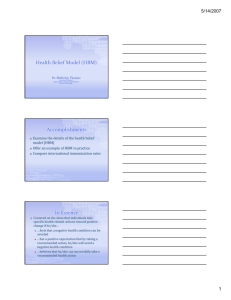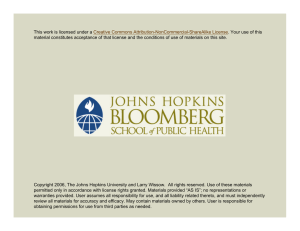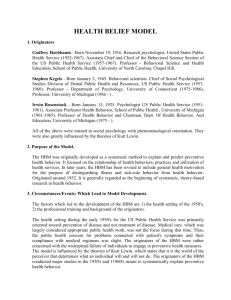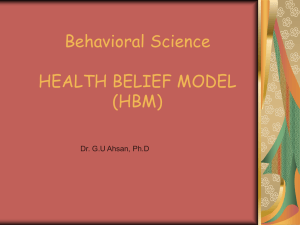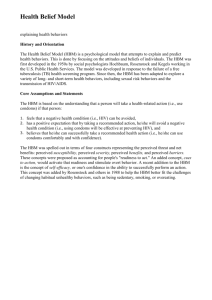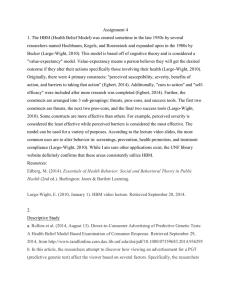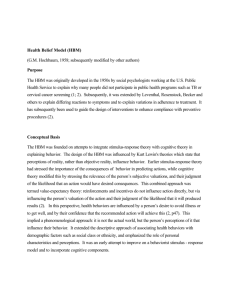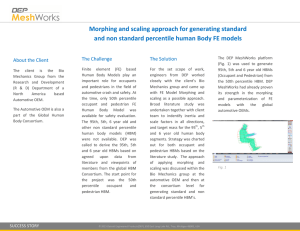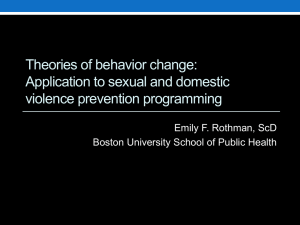H571 Week 3 - Carpenter-HBM - Natalie
advertisement
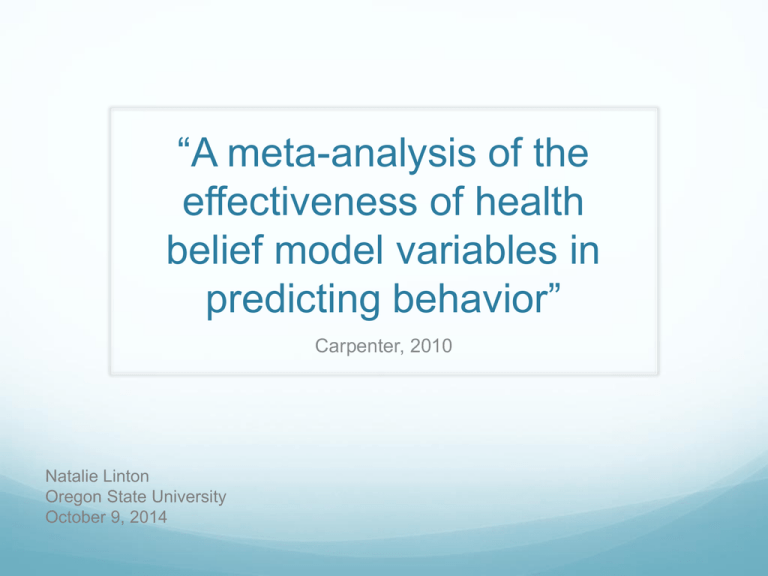
“A meta-analysis of the effectiveness of health belief model variables in predicting behavior” Carpenter, 2010 Natalie Linton Oregon State University October 9, 2014 What is the Health Beliefs Model (HBM)? Developed by the U.S. Public Health Service in the 1950s Based in value-expectancy theory measles http://xkcd.com/51/ What is a meta-analysis? Statistical methods for contrasting and combining results from different studies Meta-analyses can identify: patterns sources of disagreement Previous HBM meta-analyses: Janz & Becker 1984 barriers, benefits, susceptibility did not estimate mean effect sizes Harrison et. al. 1992 retrospective studies = larger effect sizes than prospective did not correct effect size estimates Zimmerman & Vernberg 1994 HBM prediction weak compared to Social Cognitive Theory and TRA did not examine the effects of each variable on behavior Why did Carpenter conduct a meta-analysis of the HBM? Determine whether measures of HBM concepts could longitudinally predict behavior Which elements are strong predictors? What are the moderators? Moderators found: Time between variable measurement (Time 1) and outcome behavior measurement (Time 2) Type of outcome behavior: Prevention or treatment Drug-taking or not drug-related Methodology 18 studies (2,702 subjects); published 1982-2007 Looked at only the first 4 concepts of HBM: Susceptibility (18), severity (17), barriers (17), benefits (15) Studies had to include at least 2 of the 4 Studies had to be longitudinal Time 1: measure HBM variables Time 2: measure health-related behavior outcome Outcome dichotomized as treatment (8 studies) or prevention behavior (10 studies) Outcome also dichotomized as drug-taking behavior (5 studies) or other behavior (13 studies) Results Results Perceived susceptibility Usually not correlated with health behavior (weakest predictor) Estimates mostly homogenous Subset of drug-taking studies only set for which susceptibility was positively correlated with behavior Moderator: length of time Longer periods of time between Time 1 and Time 2 associated with weaker effects r = -0.50 Perceived severity “There is something about about considering complying with a prescription to take drugs that causes people to consider the severity of the consequences for not taking the drugs more so than for other health behaviors” Moderator: length of time Severity ratings more likely to be positively correlated to behavior if the behavior is measured shortly after Time 1 r = -0.37 Perceived benefits and barriers Strongest predictors of behaviors Stronger when dealing with preventive behavior Findings mostly consistent with previous literature Moderator for perceived benefits: length of time Longer periods of time between Time 1 and Time 2 associated with weaker effects r = -0.59 http://xkcd.com/388/ Limitations Small number of studies Not enough articles providing effect sizes Variety and varying quality of measures used 16 (of 18) articles relied on convenience samples Did not test more complex models that are possible and would be better to test (studies would have needed to report full correlation matrices) Levels of Causation Intrapersonal Stream Biological/Nature BIOLOGY/ PERSONALITY Ultimate Causes 1 Social/ Personal Nexus 2 Sense of Self/Control Distal Influences 7 13 8 h Skills: Social+General 14 Proximal Predictors b c B C Others’ Beh & Atts 9 i k j l m u d e n 16 SOCIAL NORMATIVE BELIEFS o 11 w 20 q Values/ Evaluations x v 6 Interactions w/ Social Instit’s p Perceived Norms 15 5 f 10 Motivation to Comply s CULTURAL ENVIRONMENT 4 Interpersonal Bonding 19 A Nurture/Cultural 3 SELF-EFFICACY t BEHAVIORAL CONTROL Affect and Cognitions Cultural/Attitudinal Stream SOCIAL SITUATION a Social Competence g Self Determination Expectancies & Evaluations Decisions Social/Normative Stream Information/ Opportunities Knowledge/ Expectancies 17 F 21 I 22 Trial Behavior EXPERIENCES: Expectancies -- Social Reinforcements -- Psychological/Physiological Experiences 18 ATTITUDES TOWARD THE BEHAVIOR DECISIONS/INTENTIONS D E 12 r 23 J K Related Behaviors H G Discussion Why do you think Carpenter found perceived susceptibility to have almost no relationship to health behavior? Why do you think time between measures worked as a moderator for susceptibility, severity, and benefits? Why was time between measurements not a moderator for barriers? References Christopher J. Carpenter (2010): A Meta-Analysis of the Effectiveness of Health Belief Model Variables in Predicting Behavior, Health Communication, 25:8, 661-669. DiClemente, R.J., Salazar, L.F., & Crosby, R.A. (2013). Health Behavior Theory for Public Health: Principles, Foundations and Applications. Jones and Bartlett, Boston, MA. TTI slides provided to H 571 class at Oregon State University.
